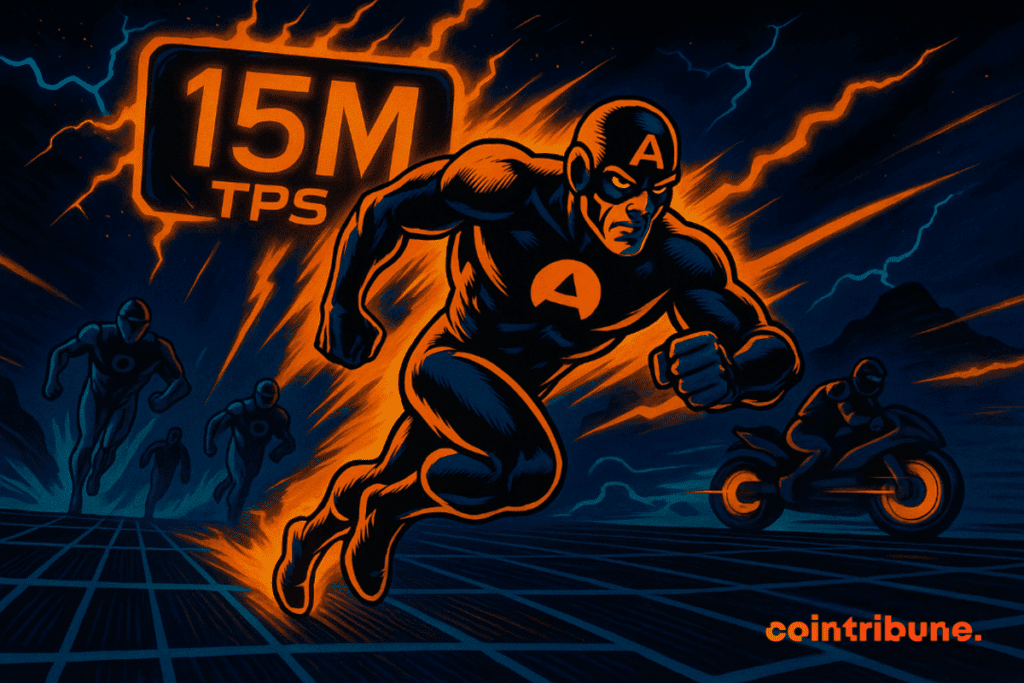Which Is The Fastest Blockchain in 2025?
On April 22, 2025, Qubic performed a public stress test on its live Layer-1 network and reached the incredible score of 15,520,000 transactions per second (TPS). The whole was independently verified in real-time by CertiK, one of the most respected security auditors in the industry.

In Brief
- Mainnet record test: Qubic reached 15.52 M TPS on April 22, 2025, audited live by CertiK — 50× faster than any other Layer-1.
- No shortcuts: Achieved with real validators, zero fees and instant finality; no Layer-2, testnet, or lab simulation.
- Why so fast? Parallel execution based on ‘ticks’ + Useful PoW transform miners’ computing power into massive processing strength.
- What this unlocks: On-chain AI workloads, DePIN sensor swarms, and real-time DeFi without congestion or gas wars.
- Takeaway: Qubic proves a single Layer-1 can be both fully decentralized and ultrafast.
Why is this so important? Because it shatters all previous TPS records, most of which came from small testnets, lab simulations, or Layer-2 rollups.
Qubic’s figure was achieved on the mainnet, with real validators, real transactions (always fee-free), and live users.
Putting 15 million TPS in perspective
Top 10 Layer-1 networks by claimed max TPS:
| Rank | Network | Test Environment | Claimed Max TPS | Notes & Context |
|---|---|---|---|---|
| 1 | Qubic | Mainnet (live) | 15,520,000 | Stress test on April 22, 2025, verified by CertiK. |
| 2 | Sui | Private testnet (100 validators) | ~297,000 | Range 10,871 – 297,000 TPS, latency ≈ 480 ms. |
| 3 | Aptos | Private testnet | 130,000 – 160,000 | Parallel execution Block-STM, finality < 1 s. |
| 4 | TON | Public “burst” testnet | 104,715 | Live test audited by CertiK. |
| 5 | NEAR Protocol | Theoretical (full Nightshade) | ≤ 100,000 | Throughput target after full sharding activation. |
| 6 | Solana | Synthetic benchmark | ~65,000 | Theoretical limit; actual mainnet TPS lower. |
| 7 | Algorand | Mainnet (post 2021 update) | 6,000 | 5× increase after consensus update; 4-5 s finality. |
| 8 | Tron | Mainnet | ~2,000 | Announced figure after launch. |
| 9 | BNB Chain | Mainnet (June 2025 snapshot) | 761 | Peak over 100 blocks; 1.5 s block time. |
| 10 | Bitcoin | Mainnet | 3 – 7 | Limited by 1 MB blocks every 10 min. |
For beginners: TPS = number of confirmed transactions per second. The more TPS, the smoother the applications, without congestion or excessive fees.
How did Qubic achieve this?
Tick-based architecture
Instead of the classic scheme “block → mempool → consensus”, Qubic bundles everything into atomic “ticks”. Each tick:
- Collects all pending transactions.
- Executes smart contract logic in parallel.
- Finalizes state instantly between validators.
All validators operate in perfect synchronization, so there is no need for extra layers, rollups, or delays.
Useful Proof of Work (uPoW)
Qubic miners already earn external cryptos (e.g., Monero) while securing the network. This computing power translates into raw processing power for the ticks, creating an integrated “supercomputer” effect.
No gas, no congestion
Zero fees mean users don’t have to bid for space, and the network can focus solely on throughput.
Developers appreciate: their apps don’t choke during high activity periods.
CertiK audit at a glance
- Max TPS: 15,527,637
- Total measured transactions: 1.51 billion
- Finality: Instant (no probabilistic delay)
- Scope: 10 peak ticks over 10 min, all on mainnet
- Verification tools: On-chain telemetry, validator logs, performance viewer
CertiK observed the network live, verified each message between validators, counted every transfer, and confirmed the authenticity of the figures.
Why speed isn’t everything
On-chain AI
Training and inference require massive data streams and millisecond confirmation. Qubic finally enables running AI pipelines on-chain.
DePIN (Decentralized Physical Infrastructure)
Sensor networks, edge routing, geospatial data sharing: millions of micro-transactions per second become possible without saturating the blockchain.
Real-time DeFi
Complex arbitrages, “flash insurance” or gamified finance with instant settlement. Immediate finality at 15 M TPS eliminates front-running and latency risks.
Towards a decentralized AGI
For a general artificial intelligence to remain censorship-resistant, its base layer must support real-time cognition.
Qubic’s tick model provides this foundation.
Decoding the jargon (Coin beginner)
- Mainnet: The live production version of a blockchain where real value circulates.
- Finality: The point from which a transaction is irreversible. Instant = no waiting delay.
- Auditor: Independent expert who validates code and results.
- Layer 1 vs Layer 2: Layer 1 is the base chain; Layer 2 overlays to scale. Qubic scales directly on Layer 1.
Overview
From Bitcoin’s 7 TPS in 2009 to Qubic’s 15.52 M in 2025, blockchain speed has multiplied by 2 million.
Yet most blockchains still delegate performance to auxiliary layers. Qubic proves that a single Layer-1 can be at once secure, decentralized, and blazing fast.
For beginners, this means:
- No waiting: Transfers are as fast as instant messages.
- No gas anxiety: Zero fees = no complex calculations.
- Ready for the future: When AI agents or sensor networks need a settlement layer, Qubic will already be ready.
Want to go further?
- Explore the record: https://explorer.qubic.org/#/performance
- Read the audit: https://qubic.org/certik-report.pdf
- Join the community: https://discord.gg/qubic
In short, Qubic didn’t just win a speed trophy, it opened a new design space where decentralization and high-frequency applications finally coexist.

Maximize your Cointribune experience with our "Read to Earn" program! For every article you read, earn points and access exclusive rewards. Sign up now and start earning benefits.
The Cointribune editorial team unites its voices to address topics related to cryptocurrencies, investment, the metaverse, and NFTs, while striving to answer your questions as best as possible.
The contents and products mentioned on this page are in no way approved by Cointribune and should not be interpreted as falling under its responsibility.
Cointribune strives to communicate all useful information to readers, but cannot guarantee its accuracy and completeness. We invite readers to do their research before taking any action related to the company and to take full responsibility for their decisions. This article should not be considered as investment advice, an offer, or an invitation to purchase any products or services.
Investment in digital financial assets carries risks.
Read more